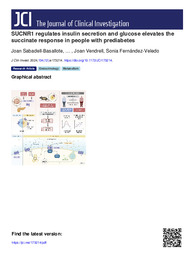Título :
SUCNR1 regulates insulin secretion and glucose elevates the succinate response in people with prediabetes |
Autor :
Sabadell-Basallote, Joan
Astiarraga, Brenno
Castaño, Carlos
Ejarque, Miriam
Repollés de Dalmau, Maria
Quesada, Ivan
Blanco, Jordi
Núñez-Roa, Catalina
Rodríguez-Peña, M.
Martínez, Laia
F De Jesus, Dario
Marroqui Esclapez, Laura
Bosch, Ramon
Montanya, Eduard
Sureda, Francesc
Tura, Andrea
Mari, Andrea
Kulkarni, Rohit N.
Vendrell, Joan
Fernández-Veledo, Sonia |
Editor :
American Society for Clinical Investigation |
Departamento:
Departamentos de la UMH::Fisiología |
Fecha de publicación:
2024 |
URI :
https://hdl.handle.net/11000/38552 |
Resumen :
Pancreatic β cell dysfunction is a key feature of type 2 diabetes, and novel regulators of insulin secretion are desirable. Here, we report that succinate receptor 1 (SUCNR1) is expressed in β cells and is upregulated in hyperglycemic states in mice and humans. We found that succinate acted as a hormone-like metabolite and stimulated insulin secretion via a SUCNR1-Gq-PKC–dependent mechanism in human β cells. Mice with β cell–specific Sucnr1 deficiency exhibited impaired glucose tolerance and insulin secretion on a high-fat diet, indicating that SUCNR1 is essential for preserving insulin secretion in diet-induced insulin resistance. Patients with impaired glucose tolerance showed an enhanced nutrition-related succinate response, which correlates with the potentiation of insulin secretion during intravenous glucose administration. These data demonstrate that the succinate/SUCNR1 axis is activated by high glucose and identify a GPCR-mediated amplifying pathway for insulin secretion relevant to the hyperinsulinemia of prediabetic states.
|
Área de conocimiento :
CDU: Ciencias aplicadas: Medicina: Fisiología |
Tipo de documento :
info:eu-repo/semantics/article |
Derechos de acceso:
info:eu-repo/semantics/openAccess
Attribution-NonCommercial-NoDerivatives 4.0 Internacional |
DOI :
https://doi.org/10.1172/JCI173214 |
Publicado en:
The Journal of Clinical Investigation |
Aparece en las colecciones:
Artículos Fisiología
|

 La licencia se describe como: Atribución-NonComercial-NoDerivada 4.0 Internacional.
La licencia se describe como: Atribución-NonComercial-NoDerivada 4.0 Internacional.
.png)